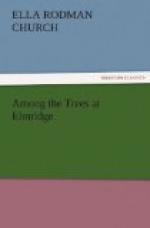“We shall find a great deal about the fir tree,” said Miss Harson, “as it is very hardy and rugged, and as common in all Northern regions as the white birch—quite as useful, too, as we shall soon see. This rugged species—which is generally called the Scotch fir—is not so smooth and handsome as our balsam-fir, but it is a tree which the people who live near the great Northern forests of Europe could not easily do without. It belongs to the great pine family and is often called a pine, but in the countries of Great Britain especially it is called the Scotch fir. Although well shaped, it is not a particularly elegant-looking tree. The branches are generally gnarled and broken, and the style of the tree is more sturdy than graceful. The Scotch fir often grows to the height of a hundred feet, and the bark is of a reddish tinge. ’It is one of the most useful of the tribe, and, like the bountiful palm, confers the greatest blessing on the inhabitants of the country where it grows. It serves the peasants of the bleak, barren parts of Sweden and Lapland for food: their scanty supply of meal often runs short, and they go to the pine to eke it out. They choose the oldest and least resinous of the branches and take out the inner bark. They first grind it in a mill, and then mix it with their store of meal; after this it is worked into dough and made into cakes like pancakes. The bark-bread is a valuable addition to their slender resources, and sometimes the young shoots are used as well as the bark. Indeed, so largely is this store of food drawn upon that many trees have been destroyed, and in some places the forest is actually thinned.”
“They’re as bad as the squirrels,” said Malcolm. “But how I should hate to eat such stuff!”
“It may not be so very bad,” replied his governess. “Some people think that only white bread is fit to eat, but I think that Kitty’s brown bread is rather liked in this family.”
The children all laughed, for didn’t papa declare—with such a sober face!—that they were eating him out of house and home in brown bread alone? Kitty, too, pretended to grumble because the plump loaves disappeared so fast, but she said to herself at the same time, “Bless their hearts! let ’em eat: it’s better than a doctor’s bill.”
“A great many other things besides pancakes are made from the tree,” continued Miss Harson, “and the fresh green tops furnish very nice carpets.”
There was a faint “Oh!” at this, but, after all, it was not so surprising as the cakes had been.
“They are scattered on the floors of houses as rushes used to be in old times in England, and thus they serve as carpet and prevent the mud and dirt that stick to the shoes of the peasants from staining the floor; and when trodden on, the leaves give out a most agreeable aromatic perfume.”
“I’d like that part,” said Clara.
[Illustration: THE BLUE SPRUCE.]




